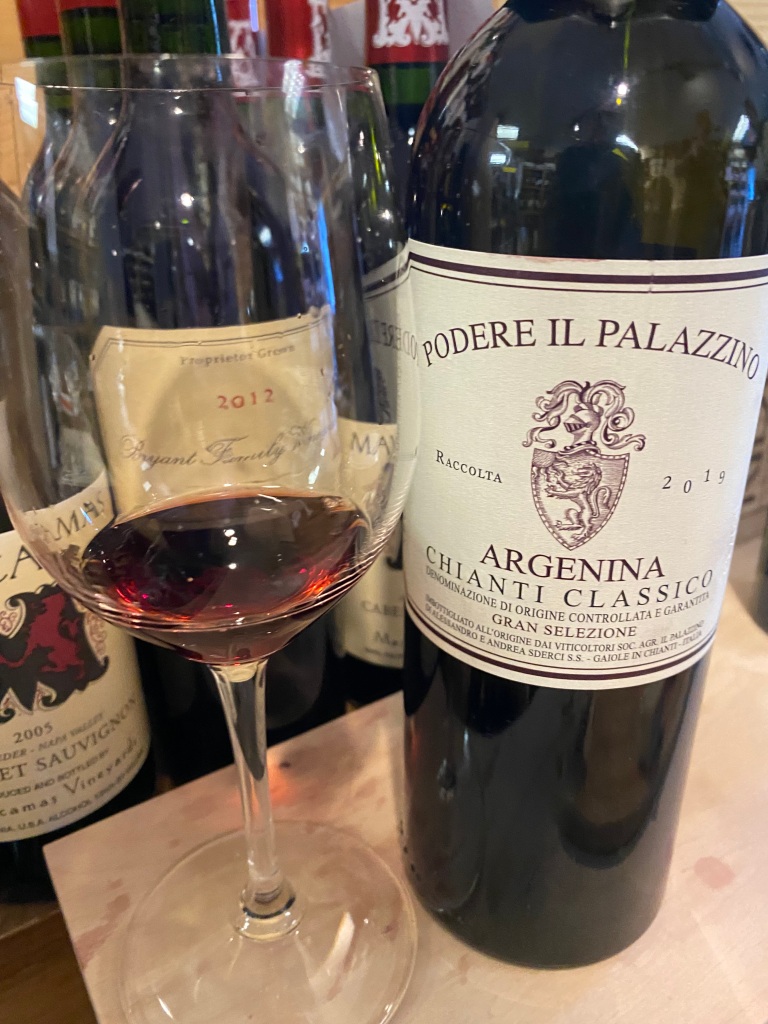It is always a pleasure to go to any wine tasting at The Fine Wine Source in Livonia, Michigan. The tasting was centered on the wines of Bibi Graetz, but I had a chance to try three other wines from Italy that were not from that winemaker, and everyone was very enthusiastic.

We had a Bruno Giacosa Roero Arneis DOCG 2022. Bruno Giacosa is a famous wine producer based in Piedmont and is known for his intensely perfumed, textured wines with the Barolo and Barbaresco appellations. He began, first by buying grapes for his father’s wines when he was fifteen. By 1960, he was ready to begin his own business as a principal producer in Barbaresco. In 1964, he was the first producer in Piedmont to bottle a single vineyard “cru” from the Santo Stefano Vineyard. His own standards are such, that in 2006 and 2010 he sold his grapes in bulk, rather than bottle them. Most of his fruit for years were from trusted growers, instead of estate vineyards. In 1982, he purchased the Fallet Vineyard in Serralunga d’Alba and he built a winery, followed by plots in La Morra and some plots in Barbaresco. He has twenty hectares and these wines are labeled “Azienda Agricola Falletto,” and the wines made from purchased grapes are “Casa Vinicola Bruno Giacosa.” He passed away in 2018 at the age of 88, and the legacy has been continued by his daughter Bruna. The Roero Arneis 2022 is pure Arneis from historical partner-growers and suppliers. The approach of having intensely aromatic wines continues with this varietal, which is locally referred to as “the white Nebbiolo.” The fruit is harvested from plots composed of mainly sandstone and marl and spontaneous fermentation and maturation take place in Stainless-Steel tanks for four months, to preserve the freshness of the grapes, and is one of the few white wines made by the house. The wine is a deep straw color with intense notes of white fruits, tropical fruits, white florals, almonds, minerals, and medicinal herbs. On the palate there are tones of pineapple, lemon, peach, and apricot in a full-bodied wine and ends with a big medium count finish of almonds and terroir. An amazing wine.

Another white wine that we had was Donnafugata Sul Vulcano Etna Bianco DOC 2020. Donnafugata is a wine company based in Sicily, by the Rallo family who have a history of winemaking going back to the 19th Century. Donnafugata was established in 1983 by Giacomo and Gabriella Rallo and is now in the hand of their children. They have five different wineries located in different sub-regions of Sicily, including on the neighboring island of Pantelleria. The wineries use both indigenous varieties and international favorites and they produce both DOC and IGT wines, because of the grapes that they grow. They have about three-hundred-thirty-eight hectares of vineyards between the islands of Sicily and Pantelleria. This wine is pure Carricante, an ancient grape varietal really only found on eastern Sicily on the volcanic slopes of Mt. Etna for at least a thousand years; there is about two-hundred hectares planted with this grape. The grape is known for its acidity and high yields, and grows best in volcanic soil and high altitude. It is the key grape in Etna DOC and can be found in the other designations of Sicily. It is also known as Catanese Bianco and Catarratto. The fruit is manually harvesting into crates, and fully inspected in the vineyard. The juice undergoes Initial fermentation in Stainless-Steel tanks, and then ages for ten months in Stainless-Steel tanks and partially in used French barriques, followed by twelve months in bottles, before release. A straw-colored wine that offered notes of green apples, mandarin oranges, eucalyptus, flint, honey, and hay. On the palate a delightful savory wine of fruit, citrus, blended with fresh acidity, refreshing salinity and a nice medium count finish of a salty quartz terroir. A really enjoyable wine.

We then had Podere il Palazzino Argenina Chianti Classico Gran Selezione 2019. Podere il Palazzino has been owned by the Sderci family since the middle of the 19th Century and famed for their Sangiovese grapes, and single vineyards. Originally, because of the rules for Chianti Classico, their wines were sold as Vino da Tavola, and after the changes of the appellation rules of 1992 and 1995, they went from Toscana IGT to Chianti Classico. They own about twenty hectares in the Gaiole Municipality basically planted with Sangiovese (between fifteen to thirty years of age) with small plots of Colorino, Malvasia Bianca and a small grove of olives. They have built a new winery, underground cellars, replanted some of the plots, and are basically all natural, and artisanal, with chemicals being banned. Argenina is one of the oldest hamlets in the town of Monti, where they have three hectares at 310-375 meters above sea level on volcanic tuffaceous soil. The wine is pure Sangiovese, hand-harvested and Initial Fermentation is done in Stainless-Steel vats at a low temperature to preserve the primary aromas of the grapes with indigenous yeasts and the Malolactic Fermentation is also natural. This wine was originally designated as “Annata” or regular Chianti Classico, but since the new appellation rules of 2013, the wine has been elevated to Gran Selezione status as it is from a single estate, committed to quality and aged for thirty months in used barriques. A ruby-red colored wine that offers notes of black cherry, plums, violets, cocoa, vanilla, and sandalwood. On the palate, a medium-bodied wine with intense tones of black cherry, plums, mixed with sweet tannins, some pepper, and cloves, with a nice finish of fruit and terroir.
